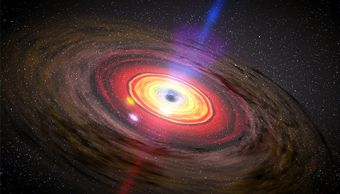 The first spectrum, measured in 2000 with the Sloan Digital Sky Survey, resembled a classic quasar: blue in color with broad emission lines. But the second spectrum, measured in 2010 as part of the BOSS Survey, didn’t exhibit those same emission lines. The broad component of one emission line, known as H-beta, had disappeared entirely, and another, known as H-alpha, had become only weakly visible.
The first spectrum, measured in 2000 with the Sloan Digital Sky Survey, resembled a classic quasar: blue in color with broad emission lines. But the second spectrum, measured in 2010 as part of the BOSS Survey, didn’t exhibit those same emission lines. The broad component of one emission line, known as H-beta, had disappeared entirely, and another, known as H-alpha, had become only weakly visible.
Spectral lines aside, the object had dimmed to one-tenth its former brightness; once identified as a quasar, the object now looked almost like a galaxy.
So the million-dollar question became: what caused such a drastic and immediate change?
Read the story at Sky & Telescope

